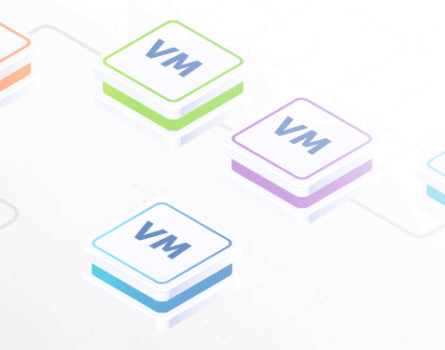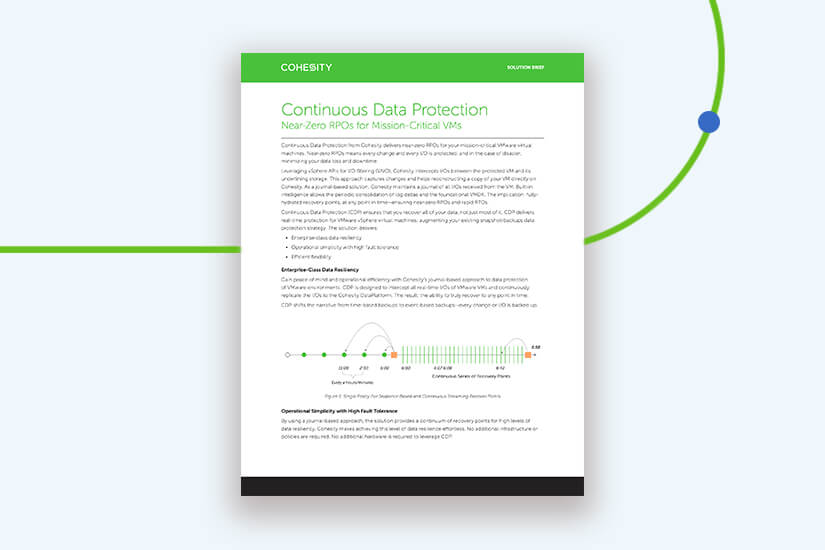What is continuous data protection?
Continuous Data Protection (CDP) is a technique to back up application data in near-real-time. Each time a change is made in the data in the primary environment, the change is observed and replicated in the backup copy, ensuring that the replica is faithful to the original all the time. The technique is also known as continuous backup or real-time backup.
Why is continuous data protection important?
Continuous data protection is critical to protecting always-on applications. In each business, there are applications that are considered mission-critical and cannot afford to go down even for brief periods. A continuous data protection solution ensures that in the case of an unforeseen event, failure, cyberattack, or outage, the backed-up copy of application data is served up near-instantly to keep operations running.
A robust continuous data protection solution helps organizations achieve near-zero data loss and the ability to recover their data seconds before the disaster struck.
How does continuous data protection work?
Continuous data protection works by ensuring that every change made in primary system data is seen and made in the backup copy, ensuring that the replica is always faithful to the original. Because each change is recorded, IT teams can, when needed, restore a system to any previous point in time.
How do I create a continuous backup?
With modern multicloud data management solutions like Cohesity, organizations have a journal-based approach to creating a continuous backup. The backup intercepts all real-time I/Os of VMs and continuously replicates the I/Os to the platform. Built-in intelligence allows the periodic consolidation of log deltas and the foundational VMDK. The implication: frequent fully-hydrated recovery points, the ability to rapidly recover to any point in time—ensuring near-zero RPOs and rapid RTOs. As a result, organizations have the ability to truly recover data to any point in time.
Why continuous data protection is the best security guard?
Enterprises that rely on continuous data protection achieve near-zero RPOs for mission-critical data sources, minimizing data loss and downtime. Continuous backup not only helps organizations best protect assets but also reduces risk.
What is the difference between Snapshots vs. Continuous data protection?
Think of a computing snapshot just like a picture—it’s capturing a system state at a particular time. To roll back to it during a restore, teams have to have scheduled the system to take a snapshot in the first place.
In contrast, continuous data protection is more like an ongoing movie. It copies data as it’s written to the disk, so over time, no matter when organizations can roll back and recover from that particular point in time.
For example, Cohesity uniquely supports snapshot and continuous data protection-based backups within a single policy framework. Once data lands on our data management platform via continuous data protection, the solution stitches multiple delta copies into a single, fully hydrated snapshot.
What are the benefits and drawbacks of continuous data backup?
The primary benefits of robust continuous data protection are near-zero RPO and near-zero data loss.
The biggest drawbacks to continuous data protection, if there are ones, are cost and space. With more data coming into organizations, there is less space to protect it. Continuous data protection requires dedicated storage, which can get expensive over time; hence, it should only be used for mission-critical data.
What is the difference between CDP vs. Snapshot-based backup?
As the name ‘continuous’ says, with continuous data protection, data is constantly replicated to the target. This technique allows for granular recovery points, including in-between snapshots. During a disaster, IT operators can choose to recover to any point in time, including seconds before the disaster, resulting in near-zero data loss.
Snapshots are periodic images of the data that organizations perform at regular intervals—from a few hours to a specific time during the day to every 24 hours. This traditional snapshot-based approach results in less flexibility and increases the risk of data loss between backup intervals.
Cohesity’s modern approach to continuous data protection
Cohesity continuous data protection allows you to recover all of your mission-critical applications from any point in time, as close as seconds before a disaster strikes. This helps you recover in near real-time and keeps your mission-critical applications operational.
There are many reasons for your organization to embrace continuous data protection from Cohesity, including:
- Achieving near-zero recovery point objectives (RPOs) and restoring the latest version of your data (or recovering data from any other point in time)
- Streamlined operations and reduced data footprint because Cohesity supports snapshot and CDP-based backups in a single policy framework
- The ability to protect data loss against human errors, data, and application corruption, a software bug, or cyberattacks










%20for%20Modern%20Enterprises%20%7C%20Cohesity&_biz_n=1&rnd=973532&cdn_o=a&_biz_z=1746261225627)
%20for%20Modern%20Enterprises%20%7C%20Cohesity&rnd=190785&cdn_o=a&_biz_z=1746261225629)